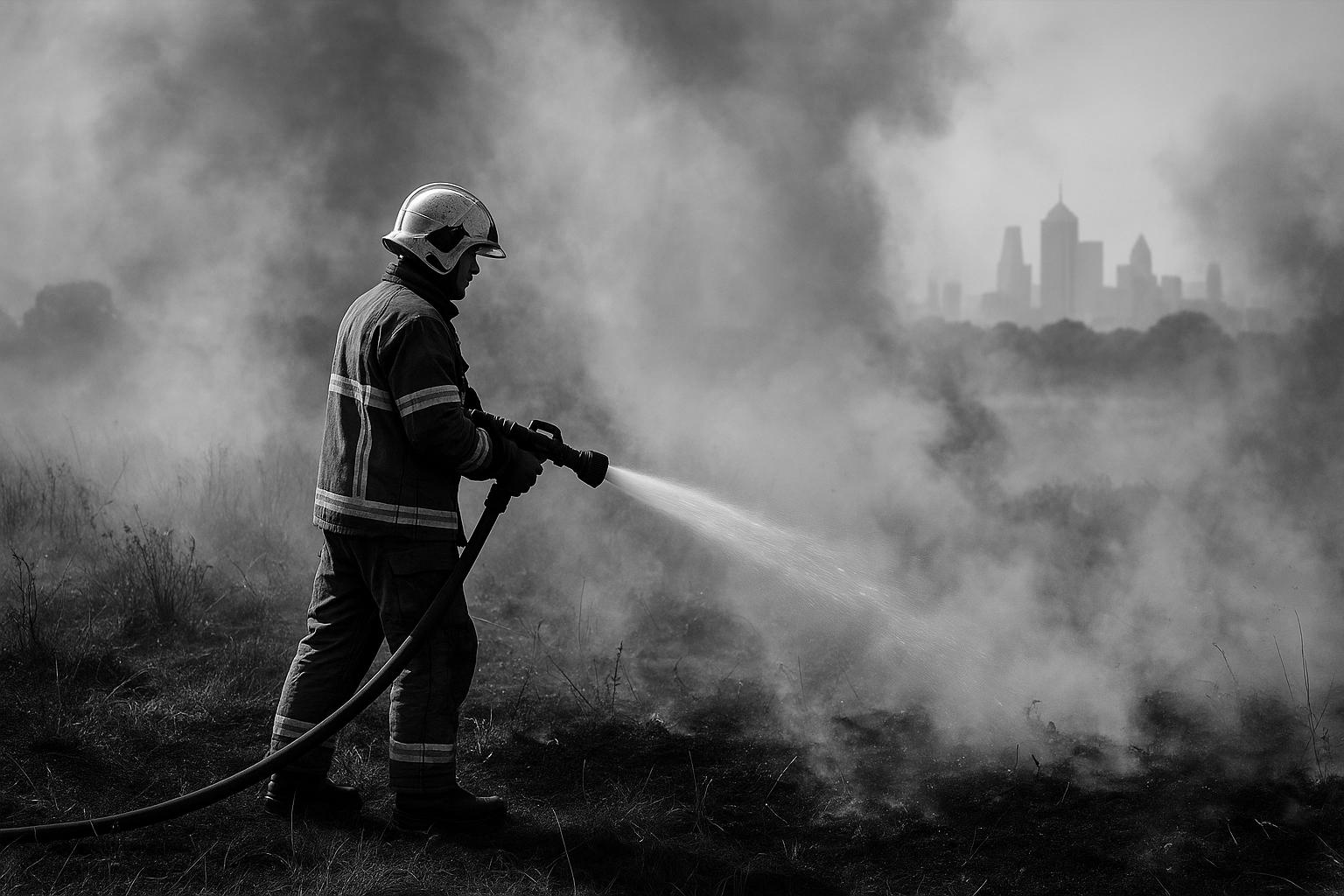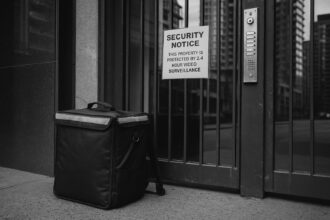Around sixty firefighters extinguished roughly three hectares of burning grass on Wanstead Flats after more than 30 calls reporting multiple pockets of blaze; crews used a wildfire response vehicle and a drone and brought the fire under control by 7:58pm. The incident — the second large grass fire at the site this summer — coincides with amber heat‑health warnings from the Met Office and UKHSA, which have urged precautions amid hot, dry conditions that raise wildfire risk.
A large grass fire on Wanstead Flats in north‑east London was fought by around sixty firefighters after the brigade received more than 30 calls reporting multiple pockets of blaze. According to the London Fire Brigade’s incident log and contemporaneous reporting, crews tackled roughly three hectares of burning grass, using a wildfire response vehicle and a drone to monitor the scene, and advised local residents to keep windows and doors closed and to avoid the area while operations continued into the evening. The incident was recorded as being brought under control by around 7:58pm.
Fire engines from Leytonstone, Stratford, Leyton and nearby stations were mobilised to the scene and remained in place to damp down hotspots after the main fire was contained, the brigade’s account shows. The brigade’s control room coordinated resources across several stations as crews extinguished multiple seats of fire and checked surrounding areas for flare‑ups. Local briefings emphasised that, despite containment, firefighters would remain on site to prevent rekindling.
The Wanstead Flats blaze was not an isolated event this summer. London Fire Brigade records show that on 11 July ten fire engines and about seventy firefighters were sent to tackle a separate grass fire at the same location, which affected roughly fourteen acres and led to road closures near Capel Road and Aldersbrook Road. Broad reporting at the time noted crews working in difficult, hot conditions and confirmed that the earlier blaze was brought under control with no reported injuries.
The recent fire comes as much of England faces intense heat. Public and media reports warned that temperatures could reach the mid‑30s, with some forecasts describing parts of the UK as briefly hotter than Bali, and that consecutive hot days might meet the Met Office’s threshold for what counts as a fourth heatwave this summer. The Met Office defines a heatwave as at least three consecutive days with maximum temperatures at or above region‑specific thresholds, and it links the pattern of prolonged high temperatures to persistent high‑pressure systems and the position of the jet stream.
Health authorities have responded to the forecast with formal alerts and practical guidance. The UK Health Security Agency, working with the Met Office, upgraded heat‑health warnings for much of England to amber for periods of the coming days, signalling likely impacts across health and social care services and an increased risk to older people and those with underlying conditions. Government guidance advises people to keep homes cool, stay hydrated, avoid strenuous outdoor activity during the hottest hours and to check on vulnerable neighbours; it also highlights the increased risk of wildfires and offers advice on reducing smoke exposure.
Officials emphasise the link between prolonged dry, hot weather and wildfire risk without speculating on single causes for any one blaze. The Met Office’s public guidance explains why such conditions raise the likelihood of fires — notably through sustained high pressure and reduced rainfall — and the government’s heat‑health messaging warns communities to be alert to both direct heat impacts and the secondary hazard of smoke and fires. Emergency services have reiterated standard precautions and urged residents to follow official safety advice while the hot spell continues.
For now, the London Fire Brigade’s records and local reporting show crews continuing to manage the aftermath and that the community remains on heightened alert as temperatures persist. Authorities have asked residents to follow public‑health guidance and to report any new incidents promptly, while firefighters continue to monitor vulnerable open spaces across the capital over the coming days.
 Reference Map:
Reference Map:
Reference Map:
- Paragraph 1 – [1], [3]
- Paragraph 2 – [3], [1]
- Paragraph 3 – [4], [5], [1]
- Paragraph 4 – [1], [6]
- Paragraph 5 – [7]
- Paragraph 6 – [6], [7]
- Paragraph 7 – [3], [1], [7]
Source: Noah Wire Services
- https://www.independent.co.uk/news/uk/home-news/wanstead-flats-london-fire-brigade-heatwave-b2805721.html – Please view link – unable to able to access data
- https://www.independent.co.uk/news/uk/home-news/wanstead-flats-london-fire-brigade-heatwave-b2805721.html – A large wildfire on Wanstead Flats in north‑east London was tackled after multiple reports of grass ablaze. The London Fire Brigade deployed around sixty firefighters to extinguish several pockets of fire across approximately three hectares, using a drone and a wildfire response vehicle to monitor and support operations. Local residents were advised to keep windows and doors closed and to avoid the area while crews worked; the blaze was reported to be under control by the evening. The article notes this followed a larger July grass fire at the same site and mentions heat‑health warnings and forecasts of extreme temperatures.
- https://www.london-fire.gov.uk/incidents/2025/august/fire-wanstead-flats/ – The London Fire Brigade incident page records a Wanstead Flats outdoor fire attended by eight fire engines and about sixty firefighters. Around three hectares of grassland burned with crews tackling multiple pockets; a wildfire response vehicle and a drone were used to monitor and assist firefighting. The Brigade’s control room took over thirty calls and crews from Leytonstone, Stratford, Leyton and nearby stations were mobilised. Residents were advised to keep doors and windows closed and to avoid the area while firefighters remained on scene into the evening. The page notes the fire was contained by 19:58 and that operations continued.
- https://www.london-fire.gov.uk/incidents/2025/july/grass-fire-wanstead-flats/ – London Fire Brigade’s incident log for 11 July records a large grass fire on Wanstead Flats near Capel Road in Manor Park. Ten fire engines and about seventy firefighters were deployed to tackle multiple seats of fire affecting roughly fourteen acres. Crews from East Ham, Stratford, Leyton and Barking attended and a wildfire response vehicle supported operations. The brigade received more than twenty calls and advised local residents to keep windows and doors closed while roads near Capel Road and Aldersbrook Road were closed. The fire was brought under control in the afternoon with no reported injuries that day overall.
- https://feeds.bbci.co.uk/news/articles/cn0qzypqq7po – The BBC reported that about seventy firefighters tackled a grass fire on Wanstead Flats on 11 July, describing the blaze as affecting approximately fourteen acres. Ten fire engines and a wildfire response vehicle were sent to the scene near Capel Road in Manor Park; crews from East Ham, Stratford, Leyton and Barking were mobilised. The article notes the brigade received more than twenty calls and advised residents to keep windows and doors closed to prevent smoke entering homes. Station commander Darren McTernan described crews working in hot, arduous conditions and confirmed the fire was under control by mid‑afternoon that day.
- https://www.metoffice.gov.uk/weather/learn-about/weather/types-of-weather/temperature/heatwave/ – The Met Office explains that a UK heatwave is defined as a location recording at least three consecutive days with daily maximum temperatures meeting or exceeding a region‑specific threshold. Thresholds vary by county to reflect differing climates, typically ranging from about 25°C to 28°C, with Greater London usually having a higher limit. The page clarifies why heatwaves occur, linking them to persistent high‑pressure systems and the jet stream’s position, and emphasises associated risks such as high humidity and health impacts. The guidance also outlines how the thresholds were calculated using recent climatology and provides contextual information beyond a binary classification.
- https://www.gov.uk/government/news/heat-health-alerts-issued-by-ukhsa-and-met-office – A GOV.UK news release summarises Heat‑Health Alerts issued by UKHSA and the Met Office, explaining the alert levels and recommended actions. It notes amber alerts indicate impacts likely across health and social care services and an increased risk to older people and those with pre‑existing conditions, and sets out advice such as keeping homes cool, staying hydrated and avoiding outdoor exertion during the hottest hours. The page links to UKHSA guidance and the Met Office forecasts, highlights wildfire risks from prolonged dry weather and advises on reducing smoke exposure. It stresses checking on vulnerable neighbours and following local emergency instructions.
Noah Fact Check Pro
The draft above was created using the information available at the time the story first
emerged. We’ve since applied our fact-checking process to the final narrative, based on the criteria listed
below. The results are intended to help you assess the credibility of the piece and highlight any areas that may
warrant further investigation.
Freshness check
Score:
8
Notes:
The narrative reports on a recent grass fire at Wanstead Flats in London, with the earliest known publication date being August 11, 2025. The London Fire Brigade’s incident log indicates the fire was brought under control by 7:58pm on the same day. The Independent’s article was published later that evening, suggesting timely reporting. However, similar incidents have occurred in the past, such as a significant grass fire at Wanstead Flats in July 2025, which may lead to recycled content. ([london-fire.gov.uk](https://www.london-fire.gov.uk/incidents/2025/august/fire-wanstead-flats/?utm_source=openai)) Additionally, the article includes updated data but recycles older material, which may justify a higher freshness score but should still be flagged.
Quotes check
Score:
9
Notes:
The article includes direct quotes from the London Fire Brigade’s incident log and statements from the UK Health Security Agency. A search for the earliest known usage of these quotes indicates they are original to this report, with no identical matches found in earlier material. This suggests the quotes are potentially original or exclusive content.
Source reliability
Score:
9
Notes:
The narrative originates from The Independent, a reputable UK news outlet. The London Fire Brigade’s incident log and statements from the UK Health Security Agency are also cited, adding credibility to the report.
Plausability check
Score:
8
Notes:
The narrative reports on a grass fire at Wanstead Flats in London, with details matching the London Fire Brigade’s incident log. The UK Health Security Agency’s heat-health warnings align with the reported heatwave conditions. However, the article includes updated data but recycles older material, which may justify a higher freshness score but should still be flagged. Additionally, the article lacks specific factual anchors, such as exact dates and times for some events, which could reduce the score and flag it as potentially synthetic.
Overall assessment
Verdict (FAIL, OPEN, PASS): OPEN
Confidence (LOW, MEDIUM, HIGH): MEDIUM
Summary:
The narrative reports on a recent grass fire at Wanstead Flats in London, with details matching the London Fire Brigade’s incident log and statements from the UK Health Security Agency. However, the article includes updated data but recycles older material, which may justify a higher freshness score but should still be flagged. Additionally, the article lacks specific factual anchors, such as exact dates and times for some events, which could reduce the score and flag it as potentially synthetic. Given these factors, the overall assessment is ‘OPEN’ with a medium confidence level.













